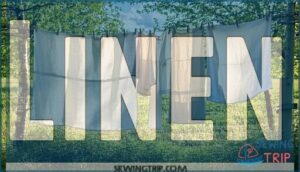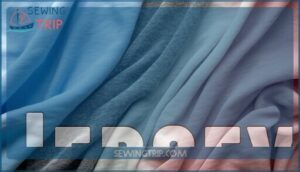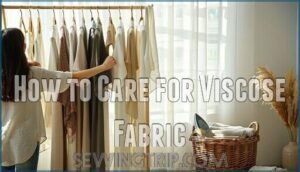This site is supported by our readers. We may earn a commission, at no cost to you, if you purchase through links.
 Viscose fabric doesn’t directly make you sweat more, but it can trap moisture against your skin.
Viscose fabric doesn’t directly make you sweat more, but it can trap moisture against your skin.
This semi-synthetic material absorbs sweat well initially—better than polyester—but struggles with quick evaporation.
Think of it like a sponge that soaks up water but takes forever to dry out.
When you’re active or in warm weather, viscose can feel clingy and uncomfortable as it holds onto that moisture.
It’s breathable enough for casual wear but won’t be your best friend during intense workouts or hot summer days.
The fabric’s weave and weight also play key roles in how it handles your body’s natural cooling system.
Table Of Contents
- Key Takeaways
- What is Viscose Fabric?
- How Does Viscose Fabric Interact With Sweat?
- Does Viscose Fabric Make You Sweat?
- Does Viscose Fabric Show Sweat Marks?
- Does Viscose Fabric Absorb Water?
- Does Viscose Fabric Cause Body Odor?
- Pros and Cons of Viscose Fabric
- Viscose Vs. Other Summer Fabrics
- Summer Fabric Dos and Don’ts
- How to Care for Viscose Fabric
- Frequently Asked Questions (FAQs)
- Conclusion
Key Takeaways
- Viscose doesn’t make you sweat more – it actually absorbs moisture well initially, but the fabric struggles with quick evaporation, making you feel damp and clingy when you’re active or in warm weather.
- You’ll stay comfortable in light activities – viscose works great for casual wear and air-conditioned spaces, but it won’t be your friend during intense workouts or hot summer days when you need rapid moisture wicking.
- Sweat marks aren’t usually visible – the fabric’s superior absorption capabilities and breathable structure help conceal perspiration, keeping you looking fresh under normal conditions.
- Choose cotton or linen for demanding situations – while viscose offers a nice balance of comfort and style, you’ll want more breathable alternatives like cotton when you know you’ll be sweating heavily.
What is Viscose Fabric?
Viscose fabric is a fascinating blend of nature and science that’s caught between two worlds.
This semi-synthetic material starts its journey as wood pulp or cotton linters, which undergo extensive chemical processing to create cellulose fibers.
Think of it as nature’s raw materials getting a high-tech makeover.
The viscose manufacturing process transforms these cellulose sources into smooth, silk-like fibers through a complex series of chemical baths and treatments.
Unlike purely synthetic fibers such as polyester, viscose retains some natural characteristics while gaining enhanced properties through its engineered composition.
What makes viscose unique among fabric types is its dual personality.
It’s neither fully natural like cotton nor completely synthetic like nylon.
This hybrid nature gives viscose distinctive fiber characteristics that set it apart from other moisture wicking fabrics.
The cellulose source provides natural breathability, while the manufacturing process creates uniform fibers with consistent performance.
Understanding viscose properties helps explain why it’s become such a popular choice for everything from summer dresses to athletic wear.
To maintain its quality, proper viscose care tips are necessary to guarantee the fabric remains durable and comfortable.
How Does Viscose Fabric Interact With Sweat?
Understanding how viscose interacts with your body’s natural cooling system is key to making smart fabric choices for warm weather.
This semi-synthetic material has unique properties that affect moisture management, airflow, and sweat visibility in ways that might surprise you.
Viscose’s Moisture Absorption
When you’re dealing with sweat, moisture control becomes your fabric’s superpower.
Your fabric’s moisture-wicking prowess is the secret to staying cool and comfortable.
Viscose’s cellulose fibers contain microscopic nanopores that excel at sweat absorption, pulling moisture away from your skin like tiny sponges.
This moisture wicking fabric doesn’t just trap perspiration—it actively manages humidity regulation through its breathable structure.
The cooling effects happen because viscose allows moisture to evaporate efficiently, preventing that sticky, uncomfortable feeling.
Unlike synthetic materials that repel water, viscose fabric sweat management works by embracing moisture, then releasing it through natural evaporation for superior fabric breathability and comfort.
Viscose’s Breathability
Building on viscose’s moisture absorption capabilities, the fabric’s breathability sets it apart from synthetic alternatives.
The nanopores within viscose fibers create exceptional airflow management, allowing heat to escape while preventing moisture buildup against your skin.
Here’s what makes viscose breathable clothing so effective:
- Superior air permeability – ranging from 223 to 306.4 cm³/cm²/sec depending on knit structure
- Natural cooling effects through enhanced evaporation and temperature regulation
- Better sweat reduction compared to polyester and other moisture-trapping synthetics
- Lightweight construction that doesn’t cling, promoting continuous air circulation
This fabric breathability means you’ll stay comfortable longer, making viscose fabric sweat management particularly effective for summer wear.
Viscose is often used for summer clothing due to its ability to keep the wearer cool.
Viscose’s Sweat-Concealing Ability
Beyond its absorption prowess, viscose fabric excels at sweat concealing through moisture management and breathable clothing technology.
Viscose’s secret weapon: advanced moisture control that keeps sweat invisible while you stay confidently cool.
When you’re dealing with summer heat, this fabric’s sweat reduction capabilities keep you looking fresh. Its moisture control system prevents visible wet spots, while fabric breathability guarantees maximum heat regulation for superior summer comfort.
To minimize sweating issues, consider wearing clothes with sweat reduction technology that helps keep you dry.
| Sweat Scenario | Viscose Performance | Visual Result |
|---|---|---|
| Light perspiration | Absorbs 400% fabric weight | No visible marks |
| Moderate sweating | Locks moisture in nanopores | Maintains dry appearance |
| Heavy perspiration | May reach saturation point | Potential slight dampness |
Does Viscose Fabric Make You Sweat?

You might wonder if viscose fabric actually makes you sweat more.
The answer isn’t straightforward.
Viscose’s moisture management properties work differently than synthetic materials.
This breathable textile draws sweat away from your skin through its natural absorption capabilities, keeping you relatively dry.
However, viscose can feel clingy when saturated with moisture, which some people interpret as increased sweating.
The fabric’s breathable nature promotes air circulation, preventing the trapped heat you’d experience with polyester.
For summer wear, viscose performs well under normal conditions, though heavy sweaters might notice dampness.
Understanding the satin sweat factors can also provide insights into how different fabrics impact comfort and temperature regulation.
Does Viscose Fabric Show Sweat Marks?
Viscose fabric excels at concealing sweat marks, making it a smart choice for summer wear.
This moisture-wicking champion works behind the scenes to keep you looking fresh and confident.
The fabric’s superior sweat absorption capabilities draw perspiration away from your skin before it can create visible stains.
Unlike synthetic materials that trap moisture on the surface, viscose’s breathable textiles allow air to circulate freely, promoting quick evaporation.
This moisture management system prevents the dreaded sweat patches that plague many summer fabrics.
Here’s how viscose properties tackle sweat visibility:
- Rapid Absorption: The fabric’s cellulose fibers instantly wick moisture away from your body
- Enhanced Breathability: Open weave structure promotes airflow and prevents moisture buildup
- Natural Camouflage: The fabric’s texture and draping qualities mask any potential dampness
While viscose won’t make you completely sweat-proof, its moisture absorption and fabric breathability work together to minimize visible sweat marks, keeping you comfortable during warm weather activities.
Does Viscose Fabric Absorb Water?
Your curiosity about viscose’s relationship with water reveals something fascinating about this fabric’s molecular structure.
Viscose fabric excels at water absorption thanks to its unique cellulose-based composition and nanopore structure.
This plant-derived material acts like a tiny sponge, pulling moisture away from your skin efficiently.
Unlike synthetic fabrics that create a barrier, viscose’s moisture absorption capabilities work in your favor.
The fabric draws sweat and humidity into its fibers, then allows natural evaporation through its breathable weave.
This moisture management system creates a cooling effect that keeps you comfortable throughout the day.
What makes viscose special is its balanced approach to water absorption.
While cotton can become heavy when wet and polyester repels moisture entirely, viscose strikes the perfect middle ground.
It absorbs enough water to keep your skin dry without becoming waterlogged or clingy.
The fabric’s sweat absorption properties make it particularly effective for everyday wear.
You’ll notice less dampness against your skin, and the fabric breathability guarantees that absorbed moisture doesn’t stick around long enough to cause discomfort.
Viscose’s ability to manage moisture creates a comfortable wearing experience, making it ideal for daily use, with its moisture management system working to keep you dry.
Does Viscose Fabric Cause Body Odor?
While viscose fabric effectively absorbs water, many people wonder about its relationship with fabric odor and body smell.
The good news? Viscose doesn’t inherently cause body odor—bacteria do.
This cellulose-based material actually works as your ally in odor management through its unique moisture-handling properties:
- Sweat Absorption Excellence: Viscose’s natural fibers pull moisture away from your skin, creating an environment less favorable for odor-causing bacteria.
- Bacterial Growth Inhibition: Unlike synthetic fabrics that trap sweat, viscose’s breathable structure prevents the warm, moist conditions bacteria love.
- Superior Moisture Management: The fabric’s nanopores facilitate quick evaporation, keeping you drier longer than polyester or nylon alternatives.
- Natural Antimicrobial Properties: Viscose’s cellulose origin provides inherent resistance to bacterial buildup compared to synthetic materials.
- Sweat Control Benefits: By managing perspiration effectively, viscose reduces the primary source of body smell before it starts.
For ideal sweat resistant clothes performance, choose quality viscose garments and maintain proper viscose care routines to maximize these odor-fighting benefits.
Pros and Cons of Viscose Fabric
You’ve probably heard conflicting opinions about viscose fabric and whether it’s worth adding to your summer wardrobe.
Let’s break down the real advantages and disadvantages of this cellulose-based material so you can make an informed decision about your next clothing purchase.
Pros of Viscose Fabric
Beyond its silk-like drape, viscose fabric delivers impressive moisture management that’ll keep you comfortable during warm days.
This breathable fabric excels at sweat reduction through its unique cellulose structure, which naturally wicks moisture away from your skin.
You’ll appreciate the cooling effects and exceptional fabric softness that make viscose ideal for sweat resistant clothes.
The fabric breathability allows air circulation while maintaining its moisture-wicking properties, ensuring you stay fresh and dry without sacrificing style or comfort.
Viscose fabric is often used in viscose fabric production due to its desirable properties.
Cons of Viscose Fabric
Every fabric has its drawbacks, and viscose isn’t immune to these challenges.
Shrinkage issues plague this moisture-wicking material when exposed to water, while weak fibers deteriorate under stress.
You’ll notice color fading after repeated washes, plus fabric deterioration when wet conditions persist.
Unlike truly sweat-prone fabrics, viscose offers decent sweat absorption, but moisture problems arise during heavy perspiration.
The fibers lose strength when damp, making moisture management tricky compared to synthetic alternatives designed for active wear.
Viscose Vs. Other Summer Fabrics
When choosing summer fabrics, you’ll want to know how viscose stacks up against other breathable options like cotton, linen, chambray, and jersey.
Each fabric handles moisture and heat differently, so understanding their unique properties helps you make the best choice for staying cool and comfortable.
Cotton
Cotton stands as the gold standard among breathable fabrics, offering superior moisture absorption that keeps you comfortable when temperatures soar.
This natural fiber’s hydrophilic structure draws sweat away from your skin, allowing rapid evaporation—think of it as your personal cooling system.
| Property | Cotton Performance | Benefits for Summer Wear |
|---|---|---|
| Moisture Management | Absorbs 20-40% more than synthetics | Keeps skin dry and cool |
| Breathability | Excellent air circulation | Prevents heat buildup |
| Fiber Structure | Natural twisted ribbons | Creates cooling airflow |
| Odor Control | Releases odors easily | Stays fresh longer |
| Comfort Level | Soft, lightweight feel | All-day wearability |
Unlike viscose fabric and other sweat prone fabrics, cotton’s fabric breathability excels through loose fiber gaps.
Cotton benefits include superior moisture management without the heaviness that synthetic alternatives create, making it perfect for summer wear when you need reliable natural fibers.
The quality of cotton fabric products is a key factor in determining the overall comfort and performance of cotton clothing.
Linen
Nothing beats linen’s legendary breathability when you’re sweat prone.
This natural fiber’s open fabric weave creates microscopic gaps that boost air circulation by 300% compared to synthetics.
Linen benefits include absorbing 20% of its weight in moisture while drying 50% faster than cotton.
Summer linen’s superior moisture management keeps you comfortable all day.
The use of breathable linen fabrics is particularly beneficial for warm weather clothing.
| Feature | Linen Performance |
|---|---|
| Moisture Absorption | Up to 20% of fabric weight |
| Drying Speed | 50% faster than cotton |
| UV Protection | UPF 50+ (98% UV blocking) |
| Breathability | 300% better than synthetics |
Chambray
Chambray stands out among breathable fabrics as your go-to cotton alternative for summer wear.
This lightweight fabric blend delivers exceptional moisture management through its fine weave structure, absorbing sweat while maintaining excellent fabric breathability that rivals viscose fabric performance.
| Feature | Chambray Performance |
|---|---|
| Sweat Absorption | Excellent moisture wicking |
| Breathability | High airflow circulation |
| Heat Retention | Minimal buildup |
| Stain Visibility | Moderate concealment |
| Chambray Care | Easy maintenance |
The key benefits of chambray, including its breathability and sweat absorption capabilities, make it an ideal choice for summer clothing, providing comfort and durability with its easy maintenance.
Jersey
Jersey fabric stands out as your go-to choice when you’re caught between comfort and performance. This flexible knit textile offers superior moisture management compared to viscose fabric, thanks to its unique construction that creates tiny air pockets for enhanced breathability.
Unlike woven fabrics, jersey’s knit structure allows it to stretch and move with your body while efficiently wicking sweat away from your skin. You’ll find that 100% cotton jersey versions work best for summer wear, as they combine natural fiber benefits with jersey’s inherent breathability.
| Feature | Jersey Fabric | Viscose | Cotton Woven |
|---|---|---|---|
| Moisture Wicking | Excellent | Good | Moderate |
| Stretch & Comfort | High | Low | Low |
| Breathability | Superior | Good | Fair |
| Durability | High | Moderate | High |
Jersey’s fabric softness makes it ideal for all-day wear, while its breathable textiles properties guarantee you stay cool. This summer knit maintains its shape better than viscose fabric while offering comparable sweat absorption capabilities.
Summer Fabric Dos and Don’ts
When selecting fabrics for hot weather, you’ll want to prioritize natural fibers that work with your body’s cooling system rather than against it.
Avoid synthetic materials and heavy weaves that trap heat and moisture, creating that uncomfortable sticky feeling we’ve all experienced on sweltering summer days.
Summer Fabric Dos
When summer heat strikes, you’ll want breathable fabrics that work with your body’s natural cooling system.
Natural materials like cotton, linen, and viscose fabric offer superior moisture management compared to synthetic alternatives.
These summer wear champions absorb perspiration while allowing air circulation, preventing that sticky feeling synthetic fabrics create.
Viscose fabric stands out for its exceptional fabric breathability and sweat-wicking properties.
Choose loose-fitting garments in these materials, and you’ll stay comfortable even when temperatures soar.
Proper fabric care maintains their moisture-managing abilities season after season, ensuring your summer wear remains effective.
Summer Fabric Don’ts
While choosing the right summer fabrics can keep you cool, certain materials act as sweat triggers and should be avoided.
These fabric choices create heat management nightmares that’ll leave you uncomfortable and damp.
Here are the biggest summer wear culprits:
- Polyester and synthetic blends – trap moisture against your skin like a plastic bag
- Denim – heavy weave blocks airflow, turning you into a walking sauna
- Leather – zero breathability means instant stickiness when temperatures rise
- Viscose fabric – despite being breathable, its moisture absorption can increase sweating concerns
- Silk – repels water but becomes unpleasantly moist, retaining odors
Skip these materials for breathable options that prioritize moisture management over style alone.
How to Care for Viscose Fabric
Proper fabric care transforms your viscose garments from potential sweat magnets into comfortable, long-lasting wardrobe staples.
Understanding viscose’s unique properties helps you maintain its moisture-wicking abilities while preventing common issues like shrinkage and color fading.
Here’s your essential viscose fabric care roadmap:
- Viscose Washing: Use cold water on gentle cycle or hand wash to prevent fiber damage and shrinkage prevention
- Color Preservation: Turn garments inside out before washing and avoid direct sunlight during drying
- Viscose Ironing: Iron on low heat while damp, using the inside-out method for fabric softening
- Moisture Management: Hang garments immediately after washing to maintain proper sweat management capabilities
Your viscose fabric maintenance routine doesn’t need to be complicated.
These simple steps preserve the fabric’s breathability and moisture-absorbing qualities that make it ideal for warm weather.
Remember, wet viscose fibers are more fragile, so gentle handling during fabric care prevents weakening.
With proper attention, your viscose pieces will continue managing sweat effectively while looking fresh season after season.
To prevent damage, it’s vital to follow the viscose care tips for washing and drying.
Frequently Asked Questions (FAQs)
Is viscose fabric good for hot weather?
Viscose won’t leave you high and dry in scorching temperatures.
This cellulose-based fabric absorbs moisture efficiently, keeping you comfortable while its breathable structure allows sweat to evaporate naturally, making it surprisingly suitable for warm weather.
What are the disadvantages of viscose?
You’ll face shrinkage when washing, wrinkles forming easily, fabric weakening when wet, and potential mildew issues. Light exposure deteriorates fibers over time, requiring careful maintenance.
Does viscose make you sweat more?
Viscose won’t make you sweat more than usual.
This moisture-wicking fabric actually absorbs sweat and allows evaporation, helping you stay cooler.
However, excessive sweating might overwhelm its absorption capacity, creating visible stains.
Is viscose good for working out?
Ironically, this "breathable" fabric can become your gym nemesis. Viscose’s moisture-absorbing properties work against you during intense workouts, trapping sweat and becoming heavy, clingy, and uncomfortable when saturated.
Is viscose fabric suitable for hot climates?
You’ll find viscose surprisingly comfortable in hot climates. It’s breathable, absorbs moisture effectively, and keeps you cool by managing sweat. The fabric’s cellulose fibers create natural ventilation that prevents overheating.
Can viscose clothing be worn during workouts?
You can wear viscose during light workouts, but it’s not ideal for intense exercise.
While it absorbs moisture well, viscose weakens when wet and may cling uncomfortably during heavy sweating sessions.
How does viscose compare to bamboo fabric?
In the context of fiber face-offs, bamboo fabric takes the crown for moisture management.
While viscose absorbs sweat effectively, bamboo’s naturally antimicrobial properties and superior breathability make it cooler and more odor-resistant for active wear.
Does viscose fabric pill after multiple washes?
Viscose can pill after repeated washing, especially when wet fibers weaken and friction occurs.
You’ll notice more pilling with lower-quality viscose or aggressive washing cycles that stress the delicate cellulose fibers.
Is viscose fabric good for sensitive skin?
Like a gentle breeze on delicate petals, viscose’s smooth cellulose fibers won’t irritate sensitive skin.
Its breathable structure and moisture-wicking properties create a comfortable microclimate, while its hypoallergenic nature makes it suitable for those with skin sensitivities.
Conclusion
Knowledge is power, but fabric choice is comfort.
Understanding "does viscose fabric make you sweat" helps you make smarter wardrobe decisions.
Viscose won’t trigger excessive sweating, but it’ll hold moisture longer than breathable alternatives like cotton or linen.
You’ll stay comfortable in air-conditioned spaces and light activities, though you might feel sticky during workouts or hot weather.
Choose viscose for its soft drape and casual elegance, but keep cotton handy for summer’s most demanding days, considering viscose fabric.
- http://www.fitnessmagazine.com/health/body/healthy-toolkit/sweat-health-benefits/
- http://news.bbc.co.uk/dna/place-lancashire/plain/A593732
- https://www.theguardian.com/uk-news/2023/jun/11/a-months-rain-could-fall-over-uk-but-it-will-still-be-hotter-than-monaco
- https://www.tandfonline.com/doi/abs/10.1080/09505439609526436?journalCode=csac20
- https://sewport.com/
















